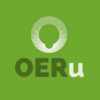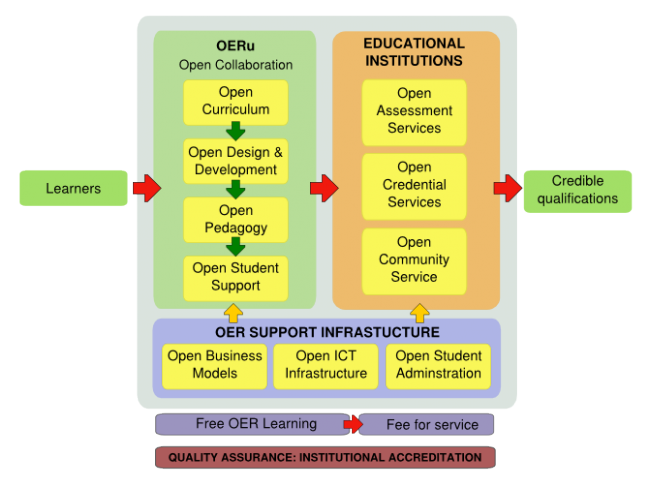Introduction

Contents
The OERu will:
|
Introducing the OERu framework of frameworks typology
The design and development of the OERu is organised hierarchically and best described as a framework of frameworks. The framework starts with a high level overview, with each of the subsequent levels increasing in the level of corresponding detail:
- OERu concept: A theory and call to action (this page)
- OERu logic model: A high level framework identifying the inputs, initiatives leading to the ultimate outcomes and impact for the project.
- Initiative planning hubs: The coordination nodes for the range of activities required to implement the OERu.
- Activities: Individual project activities with detailed milestones, key performance indicators and specified outputs.
The OERu concept
The OERu aims to create a sustainable innovation partnership between accredited educational institutions which will provide free learning to all learners with pathways to gain academic credit from formal education institutions around the world. It is based on the community service and outreach missions of tertiary education providers to develop parallel delivery systems (now possible with the open web and free content licensing of learning materials) that will augment existing educational provision. Figure 1 below provides an overview of the OERu concept depicting a stairway to success for OER learners.

The OERu is an open network and public-private partnership (PPP) including post-secondary institutions, the private sector, non-profits, government and international agencies. This OER ecosystem aims to serve both formal and informal learners by creating more flexible and affordable pathways to meet diverse student needs.
Introducing a conceptual framework for the OERu
The design, development and implementation of a sustainable and scalable OERu concept is an ambitious international collaboration project. The conceptual framework provides a structure for organising the range of activities, processes and constituent components necessary to achieve the desired results. The conceptual framework forms the basis for the logic model for the OERu.
The problem
Individuals are free to learn from OER hosted on the open web. The problem is that learners who access digital OERs on the web and acquire knowledge and skills either formally or informally, alone or in groups, cannot readily have their learning assessed and subsequently receive appropriate academic recognition for their efforts.
The solution
The core mission of any modern university is to contribute to society as a community of scholars through the pursuit of education, learning and research. Many publicly funded post-secondary institutions also incorporate the mission of community service to serve the wider interests of the communities in which they operate by sharing expertise and scholarship for the benefit of society. By combining OER with the community service mission, it is possible to create what Taylor[2] has called a “parallel universe” of higher education delivery to complement and augment existing provision, especially for those who lack the means to follow traditional learning paths. Moreover, the OERu concept is a means whereby education at all levels can be more accessible, more affordable and more efficient by reinvesting savings of shared course development back into the formal teaching operations.
Introducing the OERu initiatives and planning framework
The ultimate outcome of the OERu collaboration is to ensure that OER learners can achieve credible qualifications. Quality assurance and institutional accreditation provided by registered anchor partners is the foundation stone on which the OERu collaboration will be built.
Professor Jim Taylor, from the University of Southern Queensland, points out that the OERu will create a parallel learning universe to augment and add value to traditional models of delivery through open collaboration networks. Taylor[3] highlights that conventional supply of education using traditional delivery methods will not the meet the demands for access to higher education, requiring for example, the doubling of provision for post-secondary students over the next decade. The OERu concept will provide a stairway to credible credentials based solely on OER and the logic model provides a framework for designing the OERu system.
Inputs for the logic model include, existing open content, open textbooks, open access journals, open courseware, OER, and open source software infrastructure. The OER logic model is designed to address the current gaps in the OER ecosystem including open curriculum, open student support, open assessment and open accreditation.
The logic model distinguishes among three broad categories of initiatives (i.e. core components) required to achieve a sustainable OERu system:
- OERu open collaboration includes the collaborative initiative necessary to provide free learning using OER.
- OER support infrastructure incorporates the cross-cutting infrastructure needed to support the operations of the OERu.
- Educational institution services refer to the initiatives that will be provided by participating institutions on a cost-recovery basis.
Each category comprises a number of initiatives represented by the yellow blocks in Figure 2 below. These are described in more detail on the logic model page (Level 2 of the framework of frameworks).
References
- ↑ Taylor, J.C. 2007. Open courseware futures: Creating a parallel universe. e-Journal of Instructional Science and Technology (e-JIST), Vol 10, No. 1. Online: https://ascilite.org/archived-journals/e-jist/docs/vol10_no1/papers/full_papers/taylorj.pdf Retrieved 16 January 2011.
- ↑ Taylor, J.C. 2007. Open courseware futures: Creating a parallel universe. e-Journal of Instructional Science and Technology (e-JIST), Vol 10, No. 1. Online: http://www.ascilite.org.au/ajet/e-jist/docs/vol10_no1/papers/full_papers/taylorj.htm. Retrieved 16 January 2011.
- ↑ Jim Taylor. 2011. The OERu: From logic model to action plan. Keynote Address. Open planning meeting for the OER for assessment and credit for students project, Otago Polytechnic, 23 February 2011, Dunedin, New Zealand.

